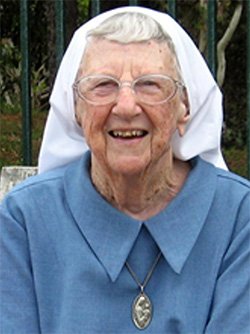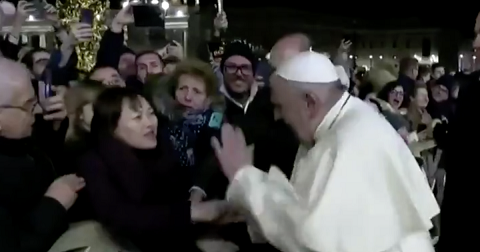Peter MALONE
BOTH JOY AND SADNESS FOR OLSH SISTERS, JUBILEES AND A DEATH
BOTH JOY AND SADNESS FOR OLSH SISTERS, JUBILEES AND A DEATH
Jubilees of Sr Josette and Sr Theresa
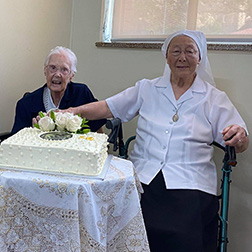
Today we express our appreciation and love to our Jubilarians – Sisters Josette and Theresa, Daughters of Our Lady of the Sacred Heart, who over seventy years ago began a journey which has taken them to places and situations that they possibly never dreamed about, on their first profession day. Amazing 70 years ago! It would be difficult for many people in our society today to even imagine this sort of selfless commitment to God and to God’s people. Their lives of dedication and long-term commitment are an inspiration to all of us.
I have asked a few people to give me some inside information on these two valiant women. It is not easy to sum up 140 years in a few minutes.
Theresa was born in Sydney and went to school in the local area completing her Secondary Education next door at Our Lady of the Sacred Heart College. Josette was born in Tumut, and very proud of it. One of my sources told me that any imported oranges that arrived in PNG had to be inspected by Josette to see if they came from Tumut. Josette completed her leaving certificate at Our Lady of the Sacred Heart College here in Kensington.

Both Sisters have spent the majority of their religious life ministering in the field of Education. Theresa in our Primary Schools and Colleges in Australia and Josette in Schools in Papua New Guinea. Both instrumental in forming the hearts and minds of young people. Some of you in this room are can attest to their wonderful teaching. Some OLSH Sisters present here today were inspired to enter the Congregation because of their witness to God’s love.
Theresa was a highly respected teacher in both primary and secondary education. Former students have described her as treating all students the same and never having any favourites. She was a wonderful staff member whose warmth, ability to laugh and join in the fun attracted people to her. During her many years in education she was drawn to help those suffering, especially young people with difficult home situations. In her later years Theresa was involved with our associates and is well known for her wonderful organization and leadership of the Pilgrimages to Issoudun. Her passion for our Charism and love of Our Lady of the Sacred Heart led her to work tirelessly at the National Shrine of Our Lady of the Sacred Heart at Randwick where she was able to spread this devotion through her witness and her many writings. Theresa is known in Community for her genuine care for others, compassion, graciousness, and positive attitude.
Josette’s teaching ministry was in Papua New Guinea, where she spent years in ‘out stations’. There were very few teachers and she soon found herself in Administration and training the local people to be teachers. From the first time she arrived in PNG she was described as being a ‘ball of energy’. It will not surprise anyone that Josette was a very competent sports coach in a variety of sports and organised many sporting carnivals for her students and her students won many competitions. Her energy and determination resulted in her making a major contribution to the future of education in the young nation. This is apparent by the awards she has received from the PNG Government for service to Education. Josette is well known for her love of ‘projects’ and from the inception of the PNG Province in 1964, she along with many other sisters worked tirelessly at fund raising to support the new Province. After retiring from teaching Josette ran a very profitable school canteen right up to the time, she left PNG. She made many friends in PNG, including members of the Chinese Catholic Community, some who are present with us today. Josette returned to Australia in 2013, Josette is known in community for her warmth, graciousness, kindness and generosity.
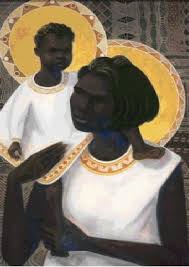
This brief summary certainly does not do justice to these heroic Sisters. Josette and Theresa have touched countless life’s over their many years of generous, dedicated, joy filled service to God and God’s people. Like Jules Chevalier and Marie Louise Hartzer, they have shown people the compassionate face of God and the church.
As I look at you today, Theresa and Josette, I can only say…your lives have been and continue to be an inspiration to us all, thank you for your witness to each one of us of what a faith filled, forever YES looks like….a life lived so close to Jesus that you cannot but radiate Joy. All that is left to say is, God bless you, thank you and congratulations to both of you, for sharing your many gifts and live with us all, may you continue to be blessed with good health and a positive spirit as you witness to God’s generous love.
I ask Moya and Pauline to present you with a rose as a symbol of our deep love and appreciation.
Josette and Theresa, we are proud of you and we love you.
Philippa Murphy olsh
Kensington, 4th January, 2020
Eulogy: Sr Emmanuel [Ena Francis Chapman] (24.05.1916 - 28.12.2019)
Come you who are blessed by my Father; take your inheritance, the kingdom prepared for you since the creation of the world. (Lk 5:4)
After spending 83 years in the Congregation of the Daughters of Our Lady of the Sacred Heart as a tireless missionary I am sure Sr Emmanuel would have received such a welcome from Him whom she had served so well.
Ena was born into a devout Catholic family from which she gained her love of God and his mother. She said that her father was not a Catholic when he met her mother in Cooktown but he received “the gift of faith without which I don’t think my mother would have married him.” Frederick Chapman was a marine engineer from New Zealand and Evelyn O’Neill a nurse from Queensland. Some time after their first baby was born, a boy called Rolla, they went to Timaru, Frederick’s home town, in the South Island of New Zealand and it was here that Eileen was born. When they moved to Auckland where it was warmer Ena was born in 1916. Nearly two years later the family came to Sydney and settled first in Randwick and then in Coogee. It was here that Ena came into contact with the Missionaries of the Sacred Heart and Eileen with the Little Sisters of the Poor the congregation she later joined. Two more children were born after the family’s arrival in Australia, Francis and Mary. Ena received her first holy Communion from Father Peter Treand, the first provincial superior of the Australian MSC’s and the father of the Australian MSC’s. Her family was very involved in the life of the Church in Randwick and in Coogee.
As the family lived near the sea and her father had a great love of the sea so did Ena and she spent a lot of time in the surf at Coogee, first with her father and later on her own. She became a good swimmer! In 1929 when she was still only thirteen years of age, because of the Depression she had to leave school and gained employment as a messenger girl in the Swan Pen warehouse on the corner of Sussex and King Streets in the city. When she was 18 after a Mission in the parish church she felt God calling her to “become a nun”. However, this was not yet possible as her sister Eileen had just gone to the Little Sisters of the Poor and Ena’s financial help was needed by the family. Two years later in 1936 even though she loved swimming and dancing she joined the novitiate of the Daughters of Our Lady of the Sacred Heart at Bowral. Her parents were very happy with her choice and looked upon the vocations of their daughters “as a precious gift from God.”
After her profession in 1938 she began on her epic journey as a teacher in Northern Australia for the next 73 years. Her first mission was to Thursday Island to where she was sent because she could swim. The sisters had to travel by boat from Thursday Island to Hammond Island for catechetics and not long before a boat carrying the sisters there capsized and one of the sisters drowned. When the war started in the Pacific in 1941 this intrepid missionary accompanied 25 children who were evacuated to Cooyar, about 70km from Dalby in Queensland and then in November, 1944 she joined the Melville Island evacuees in Carrieton, South Australia. Having had a trial run as a teacher with Sr Vianney at Our Lady of the Rosary Kensington who said she would be a good teacher, Sr Emmanuel taught from 1939 in Thursday Island and then in the two places of evacuation. After her arrival in Port Keats in 1946 she completed her school education by correspondence from Western Australia and then followed this with Theory and Practice of Education with the South Australian Department of Education. She said this gave her great satisfaction.
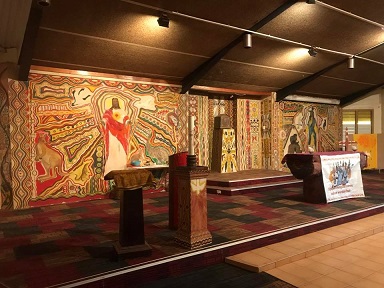
For the next 49 years in Port Keats [now called by its indigenous name, Wadeye] Melville Island, Bathurst Island and Daly River, Sr Emmanuel was an Early Childhood teacher who prepared the children for their first Holy Communion. Also, she was highly regarded by the members of both the Catholic Education Office and the N.T. Education Office for the way she embraced the new trends in education and she was considered as one of the best Early Childhood teachers of mathematics in the Northern Territory. At the end of 1995 she had to officially retire as a paid teacher. The following year when she began as a “volunteer full time teacher” of Year 2 at Wadeye she was awarded the Medal of the Order of Australia for service to education, particularly in Aboriginal communities in the Northern Territory. During the investiture she received much praise as an extraordinary Australian who for 57 years of educating young people in remote Aboriginal communities is a remarkable example of dedication and selfless service.
For the next four years she continued as a full-time classroom teacher and then for the following 12 years as a remedial reading teacher in the mornings. Then at the great age of 96 she returned to Kensington convent where she was a much-loved member of the community here and then for the last few years at St Joseph’s. It was amazing the way she was always interested in the news and who was winning in the cricket! Her ready wit and her interest in everything will be greatly missed.
The people of Wadeye have never forgotten her and when they heard of her death sent a message of sincere sympathy to the sisters because of their loss. Several of the indigenous teachers from Wadeye are present today to pay their respects.
Throughout her life her love of God, the Church, our Blessed Mother, our congregation, and the people she served was very evident. The words of St Paul to the Corinthians can certainly be applied to her, “We prove we are servants of God by great fortitude in times of suffering,....by our purity, knowledge, patience, and kindness; by a spirit of holiness and by a love free from affectation.”
Sr Emmanuel spent her entire religious life endeavouring to live out our spirituality, to make the Sacred Heart of Jesus everywhere loved.
Emmanuel thank you for your wonderful witness of a joy filled, faith filled life. May your gentle soul rest in peace.
Written by Helen Simpson olsh

INTERNATIONAL CONFERENCE ON THE SACRED HEART DEVOTION
INTERNATIONAL CONFERENCE ON THE SACRED HEART DEVOTION
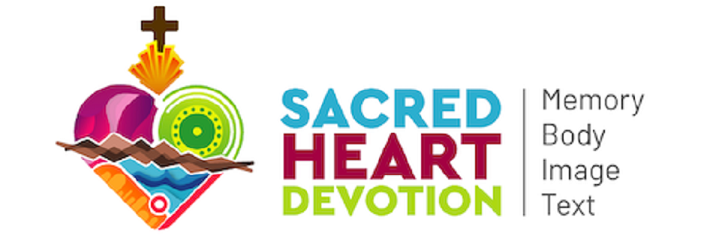
Chris Chaplin MSC, member of the General Administration was present. Here is his report.
THE SACRED HEART DEVOTION INTERNATIONAL CONFERENCE was held November 8, 9 at Villa Aurelia in Rome. It was hosted by the Priests of the Sacred Heart (Dehonians), in conjunction with the Lucerne University of Teacher Education, under the Patronage of the Pontifical Council for Culture.
Devotion to the Sacred Heart was considered from multi- disciplinary perspectives, by academics from France, Germany, Italy, Spain, Portugal, Switzerland, the US, Canada and Indonesia focussing on iconography, memory, emotion and body in the language, imagery and rituals of the Sacred Heart. Among the theologians, historians, religious scientists, sociologist and art historians who presented their research, these are a few.
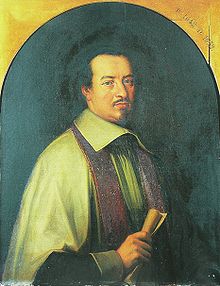
Jean-Jacques Olier
Professor David Morgan and Dr. Paul Airiau, explored the development of the iconography in the French school, with Cardinal de Berulle, Jean-Jacques Olier (founder of the Sulpicians), and Jean Eudes, who focused on the sentiments of the Heart of Christ which are signified using symbolic representations. Against this was pitted the anatomically detailed human heart of the person of Jesus promoted by the Jesuits. An interesting rivalry. The piety of Margaret Mary Alacoque in the development of the devotion received frequent mention.
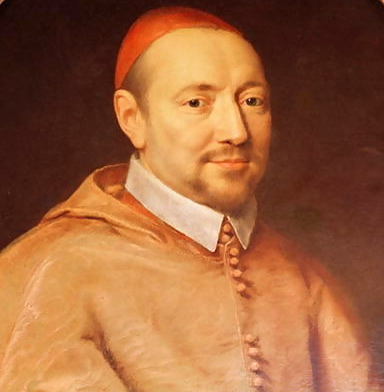
Cardinal de Berulle
A Spanish academic María Antonia Herradón Figueroa PhD, exposed the influences that the devotion has had on politics in Spain, particularly mentioning its use by conservative partisans.

One of the famous images of the anti-Catholic persecution in the Spanish Civil War was the Red militiamen shooting the statue of the Sacred Heart of Jesus in the Cerro de los Ángeles in 1936. The cry of «Viva Cristo Rey» is associated with this. General Franco later rebuilt the monument.

The theologian Professor Elke Pahud de Mortanges, investigated the relationship of embodiment to the devotion; the individual body, ecclesia as body, geo-political bodies and gender. The Sacred Heart has been a motive in all these modes. Professor Fransiskus Purwanto, reflected on the non-western expression of the devotion seen in the Shrine to the Sacred Heart in Ganjuran, Indonesia. Professor Nicolas Steeves, of the Pontifical Gregorian University, shared some enticing ideas with regard the Sacred Heart as a fundamental stimulus for theological imagination. Most stimulating was his thoughts on faith as imagination.
I look forward to further opportunities to visit such research. Perhaps they will include our own developments in Heart Spirituality.

POPE FRANCIS, SLAP, BAD EXAMPLE, ‘I APOLOGISE’
POPE FRANCIS, SLAP, BAD EXAMPLE, ‘I APOLOGISE’
“Love makes us patient,” Pope Francis told faithful gathered to celebrate the feast of the Solemnity of Mary and the 53rd World Day of Peace.
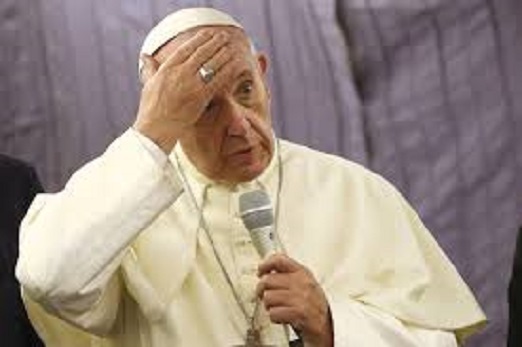
“We often lose our patience. Me too, and I apologize for the bad example I set yesterday,” he added.
In apologizing Wednesday, Pope Francis spoke about “stepping down from the soapboxes of our pride."
“So that the year that begins will be a journey of hope and peace, not in words, but in daily actions of dialogue, reconciliation and the care for creation,” he said.
The pope’s apology could teach other public figures about being contrite
Sorry doesn’t have to be the hardest word, as Pope Francis proved after slapping the hand of a woman who grabbed him
On New Year’s Day, the Pope veered off script during his address to a packed St Peter’s Square to apologise for his behaviour the previous night. Unsurprisingly, this did not involve the traditional end-of-December misdemeanour of drinking excessively and vomiting on a host’s sofa. Instead, while greeting pilgrims at the Vatican on Tuesday evening, he slapped a woman’s hand away after she grabbed him and yanked him towards her. He may have labelled the slap a “bad example” but, appropriately for a spiritual leader, the apology itself provided an immaculate blueprint for saying sorry.

Why was it so laudable? First, it came swiftly. Less than 24 hours after the incident. There was no whiff of hoping the fuss (inevitably, the slap had sparked criticism on social media) would blow over, nor of waiting for advisers to conjure a glib, legally watertight statement. Second, it was unequivocal. “So many times we lose patience – even me, and I apologise for yesterday’s bad example,” were his words in full. They contained no attempt to excuse or diminish the wrongdoing. He merely acknowledged his human fallibility, which may have chimed with those who have recently watched Netflix’s The Two Popes: the show offers an unsentimental portrait of how, in becoming pontiff, one is expected to have miraculously morphed from flawed human to spotless martyr.
Of course, it may sound odd to look to the leader of the Catholic church for tips in contrition – Francis has been criticised for not tackling the sexual abuse crisis more decisively. He’s perhaps more than adept at addressing his own personal faults than those of the institution he represents.
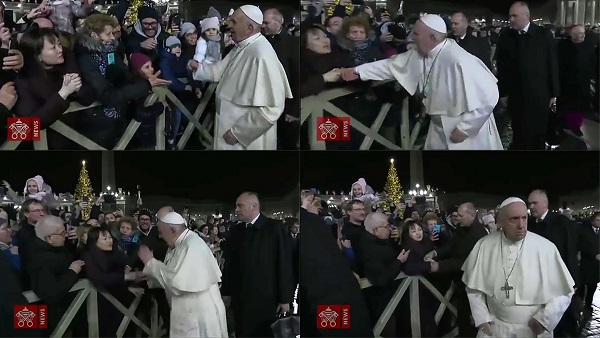
A proper apology from an adult human shouldn’t be remarkable. It’s something you’re expected to have mastered around the time you graduate from reception. In an alarming indictment of our education system, however, it seems hordes of people get through school without a basic grasp of how apologies work. While we’re discussing the best and worst trends of the last decade, I’ll venture that the 2010s were the exasperating era of the non-apology. The age in which the “I’m sorry if…” format rose to prominence, letting the wrongdoer off the hook by implying the victim had mistakenly detected offence in what was clearly an innocent act. You know, kitten slaughter, or something like that: “I’m sorry if you were offended that I murdered little Ginger. That was not my intention.”
Here’s hoping the pope has set the precedent for a new decade where public apologies are heartfelt, not laughably hollow.

NEW BOOK BY MICHAEL FALLON MSC: JESUS OF NAZARETH as portrayed in the New Testament
NEW BOOK BY MICHAEL FALLON MSC: JESUS OF NAZARETH as portrayed in the New Testament
To find the online text of this book (102) pages, go to Michael’s website, mbfallon.com
You will find the title in the first list of books on the home page. Click to Download.

JESUS OF NAZARETH as portrayed in the New Testament
by Michael Fallon msc 2020
Cover image: painting by Michael J Nelson “Jesus kneeling in prayer and meditation”

PREFACE
The story of any people reveals a pervading fascination with things divine. We are no exception. Some try to build walls round the city of the human spirit, but the divine cannot be kept out; it is within, at the heart of our being. Our questions cannot be suppressed, any more than our experiences can be denied.
One such question is ‘Who is God?’ It is a very practical question, really, for on its answer depends the way we live our lives in the light of our religious experiences. It arises when we take seriously the mystery of our living and our loving. Granted the depth of the question and the limits of our minds, it is not surprising that answers differ. The tragedy is not that our answers differ, but that they so often share an undertone of fear, arising from the insecurity that is part of the human condition.
It is here that the subject of this book becomes significant. As we shall see, those who knew Jesus of Nazareth saw in him the answer to this ultimate question. When they asked ‘Who is God?’ they came to point to Jesus, for they saw in him the human expression (the incarnation) of God. They also observed in him a way of living that revealed to them how someone free from fear of God or man could respond to the divine.
It is hard to keep impressions sharp and clear, and we have an uncanny ability not only to forget but also to distort. The historical Jesus, too, has been distorted in many ways through the centuries, with the consequence that often the Jesus presented by Christians has failed to connect with people’s life-questions. Christians have even been guilty of oppression in his name.
Yet Jesus was not an idea; he was a person who lived and died in this world of ours.
Fortunately we have in the New Testament the record of the impression he made on those who grew to love him. With disciplined study it is possible to clarify the essential features of this wonderful person, and so to correct many of the false portraits that abound. Saints and scholars will be forever refining our insights into this rich material but, while there will always be areas of debate, the New Testament, as I hope this book will show, is not unclear in its portrayal of Jesus.
I have been living with the question for many years, and wish to share with the reader what I have come to see, so that together we can come to know the real Jesus of Nazareth. The answer can be found only when we share our lives in love, and take time to relish and deepen our experiences in prayer. Studying the texts can act as a stimulus inviting us to this personal encounter. It can also guide us through the shoals of self-deception.
I hope that we can all come to know Jesus more truly, and that, listening to the desires of his heart, we may be more effective and more courageous in continuing his healing mission of love in this very lovable and very love-needy world.
Feast of Saints Peter and Paul, June 29, 2020
CONTENTS
Preface 3
Chapter One ‘God’ 5-13
Chapter Two Jesus’ Contemporaries and their image of God 14-23
Chapter Three Jesus’ Image of God 24-28
Chapter Four Jesus’ Communion with God 29-31
Chapter Five Jesus’ Love 32-38
Chapter Six Jesus: The Word of God made flesh 39-41
Chapter Seven Jesus’ Teaching about our response to God 42-50
Chapter Eight Jesus’ Conception 51-53
Chapter Nine Jesus’ Miracles 54-65
Chapter Ten Jesus died as he lived 66-73
Chapter Eleven Jesus: The Crucified One who Lives 74-87
Chapter Twelve Jesus: The Saviour of the World 88-94
Chapter Thirteen So, Who is Jesus? 95-101

ROSEMARY TAYLOR RIP. SIGNIFICANT LIFE AND MISSION. VIETNAM.
ROSEMARY TAYLOR RIP. SIGNIFICANT LIFE AND MISSION. VIETNAM.
Rosemary Taylor died last month and is to be buried on Thursday.

The MSC connection is her brother, Fr Brian Taylor, who has been working in Japan for almost sixty years. Her brother, Robert, spent some time as an MSC student.

Brian Taylor with Chris McPhee in 2018.
Here is a brief outline of her work for children in Vietnam, especially during the war.
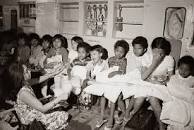
‘FRIENDS OF ALL CHILDREN’
|
: |
A trained lay worker with the Catholic Church in Adelaide, Rosemary Taylor was the only Australian woman in a team sent to Vietnam by the Australian Council of Churches in 1967 to work with women and children living in refugee camps. Rosemary has lived in South-East Asia ever since, continuing to work with the poor and underprivileged. Initially, she was joined by two other South Australian women, Sister Doreen Blackett and Margaret Moses. Other Sisters of Mercy nuns assisted in the work for varying periods. At this time Rosemary and her team, working as 'Friends of All Children,' operated a series of homes for children who had been orphaned or abandoned through the Vietnam War. Prior to the fall of Saigon in 1975, she and her assistants managed to evacuate 3,000 orphan children from the city. However, fellow workers Margaret Moses and Lee Makk of Adelaide were killed, along with 150 children, when an American plane crashed during the evacuation. ROSEMARY TAYLOR, LAST MESSAGE, 2019 |
ADOPT VIETNAM A FULLER STORY OF ROSEMARY TAYLOR AND HER ASSOCIATES, ‘FRIENDS OF ALL CHILDREN’ |
LAST MESSAGE FROM ROSEMARY TAYLOR, 2019
Meanwhile I am trying to finish yearly & accounts, & trying to simplify financial operations in view of the fact that I may soon or will eventually pass on to another state of existence. I count on Irene Duarte, 20 years younger, to be there to carry on for a longer time. FFAC was never expected to go on forever. It is a very small group and has been able to provide aid at a certain time in history. We

A few days ago I found myself reading a passage from the Book of Wisdom, & I saw it as an appropriate Christmas /New year meditation for those on my ever dwindling Newsletter List, friends who express their understanding of life in a language so different from my own, each person in a way that is utterly unique for them, as the world they must create, as their human responsibility, is utterly unique.
So in the coming year my wish for you is not focused on “prosperity”, ‘good fortune”, “health”, or even “happiness” (whatever that means), but for a continued growth in “Wisdom” which is, in my understanding, the necessary concomitant of any human progress. And with the Wisdom, a spirit of JOY renewed as we celebrate the Christmas mystery.
Rosemary Taylor
Rosemary Taylor Babylift Adoption Hero Vietnam
Story of Rosemary Taylor and her adoption work in Vietnam 1967-1975 and during the babylift.
April is the anniversary of Operation Babylift, the mass evacuation of Vietnamese orphans in the care of American connected adoption programs due to the imminent takeover of South Vietnam by North Vietnamese troops.
Rosemary Taylor did not come to Vietnam to set up an adoption program or even to work specifically with homeless children. But when she saw firsthand the suffering and the dying of so many orphans of war, she established nurseries where infants' lives could be saved and babies and older children lovingly cared for until they could be sent abroad to adoptive families. Of the several adoption programs eventually operating in Vietnam, Rosemary Taylor's program was the longest running and most extensive.
Rosemary Taylor, an Australian high school teacher, went to Vietnam in February 1967 as an educational social worker and the first Roman Catholic to join a refugee service sponsored by the Australian Council of Churches. Two months later she left her first assignment and began to work as a volunteer at Phu My, directed by the Sisters of St. Paul de Chartres. Phu My was a refuge for some 1500 people, including the homeless, the destitute, the incurably ill, and the dying, and also included an orphanage and center for polio children. A small room at Phu My was to be Rosemary's home for the next eight years.
At Phu My Rosemary met a Swiss nurse who was involved in arranging the adoptions of a few orphan children into European families. Rosemary soon began helping with the adoptions by bringing the children ready to leave for Europe to Saigon from provincial orphanages, a challenging task due to the difficulty of finding transportation. When the Swiss nurse had to leave Vietnam at the end of 1967 she asked Rosemary to be responsible for the departure of several dozen children whose adoptions were still in progress. In her book "Orphans of War" (Collins, 1988) Rosemary Taylor told of her early months working with orphans in Vietnam:
By now I had visited a dozen other orphanages in Saigon and in the provinces and begun to appreciate the dimensions of the problem of abandoned and orphan children. Nothing in my previous experience or reading had prepared me for this. I was coming into contact with hundreds of newborn babies with no identity and no prospects. There were healthy and handicapped babies; the fully Vietnamese and the mixed-race; the legitimate and the illegitimate! Many of the orphanages were run by Vietnamese Catholic Sisters, who were mostly doing the best they could under the worst conditions in a situation that was never meant to be. The offspring of men arrive one at a time for a reason. These babies came by dozens each month to the already overcrowded orphanages. They were never the center of anyone's universe and never received the nurturing warmth of parental love. They often lacked the minimum necessary to animal existence. How much more did they lack the affection and stimulation needed to promote their human development. My instinctive reaction was to resist this destruction of personality and work towards getting as many of these babies as possible into the mainstream of human development. To give them caring parents was the first step." (p. 15)
In August 1968 Rosemary and a Spanish nurse decided to open their own nursery where they could give the intensive care needed for the survival of abandoned newborn babies and where they could implement standards of hygiene and child care without the frustration inevitable as foreign intruders in an already established orphanage. Their first "nursery" was merely a rented room in a rundown building in a rat-infested alley. It was called "To Am" - warm nest.
The organization that Rosemary Taylor developed in Vietnam was primarily a salvage operation, saving the lives of as many children as possible and then sending them to the safety of adoptive homes outside of Vietnam. Starting out by herself, her team grew to include fifteen foreigners, "American, Australian, British, French, German and Spanish nurses and administrators who with Rosemary worked around the clock, receiving little or no compensation” and 400 Vietnamese nurses, childcare workers, physical therapists, early childhood development specialists, maintenance personnel, and administrative staff.
By 1972 Rosemary and her staff were operating three nurseries--huge rented houses that could accommodate large numbers of babies or older children. During 1972 alone they placed over 500 children in adoptive homes, working in liaison with professional agencies in most countries and, in particular with Terre des Hommes in Switzerland, Germany, France, Belgium and Luxemburg. From 1968 to 1972 Rosemary and her staff managed to place a total of 1132 orphans, having arranged the majority of all adoptions of Vietnamese children during those years.
In 1973 it became necessary for Rosemary Taylor's program to register under an official name in order to "continue the work we had been doing without one." In March of that year Friends of the Children of Viet Nam (FCVN) was licensed by the Colorado Department of Social Services and signed a contract with the Vietnamese government. A year later, due to internal problems within FCVN in Colorado (which was comprised of a volunteer organization providing support for Vietnamese orphanages as well as the adoption agency affiliated with Rosemary Taylor's nurseries), the adoption agency staff resigned from FCVN and negotiated a new agreement with the Vietnamese government under a new name, Friends For All Children (FFAC).
Depending heavily on volunteer help in both Vietnam and Colorado and despite a perpetual shortage of funds, Rosemary Taylor's operation to save the lives of Vietnamese orphans continued to expand during the last years of American presence in Vietnam. The work in Vietnam was financed privately for the most part by supporters in the USA, Australia, Canada, France, Germany, Belgium, England, Italy, Sweden and Switzerland. Adoptive parents were viewed as part of the team to save the children, and adoption fees were kept to an absolute minimum: "All we ever requested as a "fee" for an adoption was barely enough to cover the most obvious procedural costs." (p. 91)
In November 1973 the work was expanded to a fourth and fifth facility. Added to the second To Am Nursery, Allambie for older children, and Newhaven Nursery were Hy Vong ("Hope") intensive care nursery and Rathaven (most aptly named), used as staff living-quarters, meeting place and warehouse. By this time Rosemary Taylor's program was employing a total of about 200 Vietnamese staff, some of whom had been trained as Mothercare nursery nurses.
An American volunteer wrote home in November 1974: "Rosemary is up to her eyes in work. She returned from Australia a bundle of energy and I would guess that her optimism dwindled in the first sixty minutes. Her task is enormous, overwhelmingly complex, completely impossible, and never-ending. Her spirit is remarkable, her methods courageous, breathtaking, hazardous and dictatorial. Without her the whole team would fold up. Because its structures comprise a complex maze of ingenious channels of operation totally dependent on her leadership: simple, forthright, autocratic and totally altruistic."(p. 126)
As the political situation in Vietnam deteriorated during the early months of 1975, it became clear that an evacuation of children already assigned to overseas families, as well as of other adoptable children in FFAC care, would be necessary in order for the children to join their adoptive families. Rosemary later wrote of the tense situation that existed by the end of March 1975: "No one knew how much time we had before Saigon would fall. Some thought it might be six months, others not as long."
There were now about 600 children under FFAC care in the four nurseries, including the remaining Cambodian refugees. The children were cared for in shifts by the 400 local staff and fifteen foreign staff nurses and administrators. Should the situation in Saigon deteriorate, the Vietnamese staff would be unable to report for work, and without them there would be no way in which the rest of us could cope. It would be physically impossible to transport so many children to the airport or to the helicopter pick-up points in the event of an emergency evacuation. The radio newscasts on Easter Sunday were reporting the panic in Danang and the clogging of all circulation; it could be much worse in Saigon: "No one considered leaving the children behind. It was accepted that if the children did not depart prior to a change of regime, they would never leave Vietnam for the families that awaited them in other countries. The only logical solution in Wende's mind [Wende Grant, director of FFAC in Colorado and at that time in Vietnam helping with the children] was to evacuate our children before there was an acute shortage of food and medical supplies, before Saigon could be flooded with refugees, before the fighting was too close to the city, and before the airport could be closed by shelling or a panic-stricken populace. Once this was clear, there was no time to be lost and everyone started working on this plan immediately. We prepared memos to the nurseries warning them of the departure and the need to pack supplies for three days. Each nursery was to submit to the office the names of resident children in permanent custody with notations concerning their travel fitnes." (pp. 151-153)
FFAC staff in Vietnam and Colorado tried in vain to charter a plane for the evacuation, contacting Pan Am and other airlines. On April 4 a call came from USAID in Vietnam, notifying FFAC that the US had authorized transportation for the Vietnamese orphans scheduled to leave Saigon and offering a US military C-5A departing that afternoon. Space for 230 children was offered, and FFAC was assured that the C-5A had seats, seat belts, oxygen and emergency evacuation equipment. Rosemary and her close friend and associate Margaret Moses discussed the plan and agreed to accept the offer.
Tragically the C-5A crashed within minutes of take-off. Seventy-eight children died and ten were hospitalized. Of the eight FFAC staff who had accompanied the children, only one nurse survived. Among those who perished was Margaret Moses, Rosemary's friend from their school days in Australia who had left her position with the education department in 1971 to heed Rosemary's plea to come to Vietnam to assist her in running the nurseries.
There was no time for Rosemary and the remaining FFAC staff to mourn, for immediate arrangements had to be made to evacuate the surviving children and the other children still in the nurseries. 324 children had to be prepared again for departure, new supplies packed and identities of the surviving babies confirmed. Rosemary Taylor wrote of that terrible time: "The living still had to be cared for; there was no time to dwell upon the tragedy. I myself was numbed beyond the possibility of emotion. All the remaining staff knew what had to be done and did it with a minimum of wasted words. In the back of my mind I knew that I could "think about it later," to use one of Marg's favorite phrases." (p. 175)
One day after the crash of the C-5A, FFAC children and escorts left Vietnam on a chartered Pan Am 747. This group arrived safely in the USA.
Rosemary and three other staff members stayed on in Saigon, rejoined during the next ten days by two other staff members who had escorted children out of the country. They closed Hy Vong, giving most of the equipment, furniture and food supplies to Phu My. But then more children poured in from provincial orphanages as the Sisters commuted back and forth from the Mekong Delta, bringing children promised to families in France and Italy. Over the next three weeks the population of To Am, Newhaven and Allambie built up again to maximum capacity, after most of the local staff had been dismissed and extra supplies dispersed. Rosemary continued to process normal travel documentation for as many individual children as possible, sending them out of Vietnam on either Pan Am or Air France flights which were still operating. On April 22 Rosemary was told that she and other foreign staff "would have to evacuate very soon if necessary without our, by now, 200 children. [Major B.] seemed surprised, but realized I was serious when I said that we would not leave without the children." (p. 199)
It was next to impossible to secure a plane to evacuate the remaining children. Finally on April 26, four days before Saigon fell, a small C-141 cargo plane was obtained for the, by then, 270 children. One of the escorts later recalled: "The older children were strapped in canvas seats along the side of the fuselage with one common seat belt to secure them. Approximately seventy-five children traveled in this fashion. The remaining children were placed in blankets spread over the metal floor. The tiny babies in boxes and baskets were placed in the rear of the plane with Susan [McDonald] and the other [far too few] escorts scattered throughout. We ran out of water one hour out of Saigon." (p. 203)
Again Rosemary stayed on in Vietnam to close the nurseries: "As the plane moved away with the last of our children, I felt only an immense sense of relief and freedom, such as I'd never before experienced. The burden of all those children for so many years had been weighing intolerably. (p. 208)
On April 29 Rosemary, two other remaining staff, and the young adopted daughter of one of them, left Vietnam on one of the last helicopters to take off from the roof of the American Embassy. They spent several days on a ship before Rosemary was finally able to fly to Colorado on May 7 to assist with all that was left to be done for the FFAC children and their adoptive families.
The Australian government subsequently awarded Rosemary Taylor the decoration Member of the Order of Australia for the work she accomplished on behalf of the children of Vietnam.
In 1979 she returned to Southeast Asia, with Friends For All Children, to assist in refugee programs and in projects for orphans, handicapped and deprived children in Thailand. Today Rosemary Taylor lives in Bangkok where she continues to devote her life to needy children.
EPIPHANY/REVELATION/EVANGELISATION - PLENARY COUNCIL 2020
EPIPHANY/REVELATION/EVANGELISATION - PLENARY COUNCIL 2020

2020 in Australia is a potentially powerful year for the Church in Australia, with thought and action in prayer and discernment for the Plenary Council. An opportunity renewal and for the future of the Church.

It seemed a good moment at the beginning of the year to highlight the Plenary Council. But just as some serious focal points were emerging, the following cartoon appeared. A perspective on Plenary Council agenda.
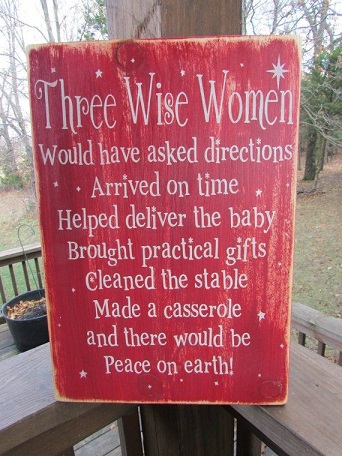
It seemed, then, a good idea, not simply to repeat the points – confirmed when the other two cartoons appeared, both from the prolific cartoonist, David Hayward, with his nom-de-plume, The Naked Pastor.
His two cartoons offer a Plenary Council challenge to our stances.

And some pertinent words from Pope Francis – to the Curia, and to all of us.
'Today we are no longer the only ones that produce culture, no longer the first nor the most listened to,' he said.
'The faith in Europe and in much of the West is no longer an obvious presumption but is often denied, derided, marginalised and ridiculed.'
'Here we have to beware of the temptation of assuming a rigid outlook.
'Rigidity that is born from fear of change and ends up disseminating stakes and obstacles in the ground of the common good, turning it into a minefield of misunderstanding and hatred.'

FIRST FRIDAY, JANUARY 2020, MONTHS OF BUSHFIRES, BUSHFIRES NOW
FIRST FRIDAY, JANUARY 2020, MONTHS OF BUSHFIRES, BUSHFIRES NOW
Each month the Chevalier Family Justice and Peace offer a theme for the First Friday.
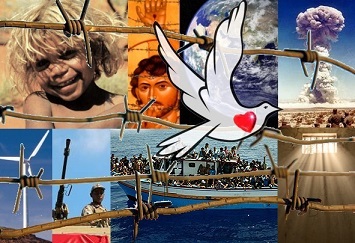
This month we have an intention here in Australia: our devastating bushfire destruction.

- Men and women have been injured. Some have died.
- Many homes and properties have been destroyed.
- Thousands have been evacuated, some by sea.

- The consequences for natural resources and re-growth will be widespread
- The consequences for local economies will affect many for a long time
- And future planning for increasing temperatures…
First Friday concern, empathy, prayer, generosity from everyone.

SOME SIGNIFICANT JANUARY DAYS FOR THE CHEVALIER FAMILY, 2020
SOME SIGNIFICANT JANUARY DAYS FOR THE CHEVALIER FAMILY, 2020

Archbishop Couppe MSC, See January 15th and January 31st
1 January,
Motherhood of God
6.January,:
Feast of the Epiphany - one of Chevalier's favourite feast. The true nature of God is manifested through the flesh of the infant Jesus.
10 January, 1854
Father Maugenest, 1829-1919, is appointed curate of Issoudun.
10 January, 1979
The FMI Sisters ~ The Daughters of Mary Immaculate ~ founded by Bishop Louis Couppé, MSC, in Papua New Guinea in 1912, elect their first General Superior. Since their foundation a FDNSC sister had been their 'Superior'.
12 January, 1877
The first MSC Constitutions are approved for 10 years by Rome.
13 January, 1985

The cause for the canonization of the lay Papua New Guinean catechist, Peter To Rot, is opened.
13 January,
World Day for Migrants and Refugees ... Chevalier responded to the evils of his time. In our time, we respond to the inhumanity of our world ... with compassion of the Heart of Jesus.
15 January, 1927
Archbishop Couppé, MSC, who died 20 July 1926 at Douglas Park, Australia, is reburied at Vunapope, Papua New Guinea.
15 January, 1930
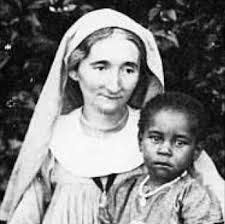
Marie-Thérèse Noblet dies. She was Mother of the Handmaids of the Lord, who were founded in Papua New Guinea by Bishop Alain de Boismenu, MSC, in 1920.
16 January,
Anniversary of Archbishop Navarre, MSC, vicar apostolic of British New Guinea.
20 January, 1925
The cause of beatification of Bishop Henri Verjus and of the Baining martyrs is introduced.
21 January, 1852
The young Father Chevalier receives his second appointment after ordination. He becomes assistant priest at Châtillon-sur-Indre.
21 January, 1907
The aged Father Chevalier and his curates are expelled from their home, the presbytery in Issoudun.
22 January, 1811
Jean-Charles Chevalier and Louise Ory, the parents of Father Jules Chevalier, are married in Richelieu.
24 January,
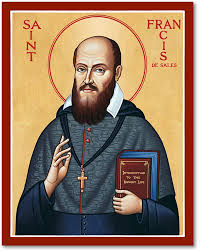
Feast Day of St Francis de Sales (1567-1622).
The 'heart' is the central image for Francis and Jane de Chantal, in their attempt to portray who God is, who the human person is and how they are intimately related. Both these figures appear in stain glass windows in the Richelieu Church.
29 January, 1861
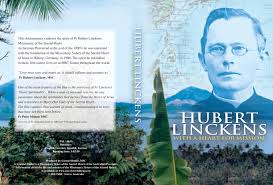
Birth and Baptism of Father Hubert Linckens, MSC, in Wijlre, Netherlands. Linckens is the historical founder of the Missionary of the Sacred Heart Sisters of Hiltrup.
31 January, 1885
The first five Daughters of Our Lady of the Sacred Heart arrive in Australia, accompanied by Fathers Couppé, and Verjus, and three Italian Brother Novices.
BLESSINGS FOR 2020, CELEBRATING MARY, MOTHER OF JESUS – AND CELEBRATING THE MOTHERING OF GOD. THE MOTHERING OF GOD Isaiah 66:12-14 New International Version (NIV) For this is what the LORD says: “I will extend peace to her like a river, and the we
BLESSINGS FOR 2020, CELEBRATING MARY, MOTHER OF JESUS –
AND CELEBRATING THE MOTHERING OF GOD.

THE MOTHERING OF GOD
Isaiah 66: 12-14,
For this is what the Lord says:
“I will extend peace to her like a river,
and the wealth of nations like a flooding stream;
you will nurse and be carried on her arm
and dandled on her knees.
As a mother comforts her child,
so will I comfort you;
and you will be comforted over Jerusalem.”
When you see this, your heart will rejoice
and you will flourish like grass;
CHRISTMAS GREETINGS AND BLESSINGS TO ALL OUR VISITORS
CHRISTMAS GREETINGS AND BLESSINGS TO ALL OUR VISITORS

Greetings to all visitors to our MSC Australia Province site and to those who receive our Province Facebook page.
And, just letting you know that we are taking a Christmas break until New Year’s Day when we will begin 2020 postings with renewed Christmas energy.
OUR CHRISTMAS MESSAGE IS OF GIFTS OF SELFLESSNESS AND JOY.
Of joy
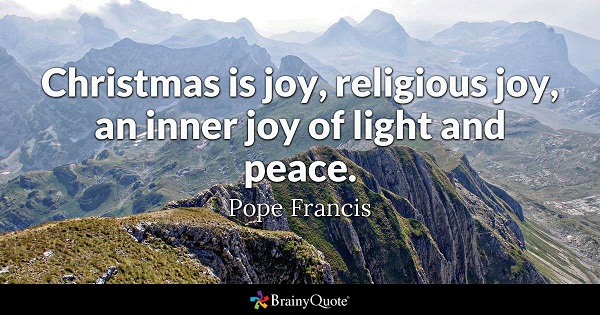
In selflessness

